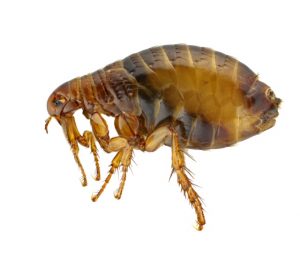
Fleas are a problem all year in Texas, however they flourish in the spring time with perfect temperatures and humidity levels. Fleas thrive in temperatures between 65-80 Fahrenheit and 75-85% humidity. This makes spring and fall ideal times for flea infestations on our pets in Texas.
The Flea Life Cycle:
Fleas are tiny parasites that survive by ingesting the blood from warm-blooded hosts. There are 2,500 species of fleas, however dogs and cats are most commonly infested with the cat flea, or Ctenocephalides felis. Fleas have four life stages: egg, larva, pupa, and adult. Understanding the life stages is important for proper treatment and prevention of fleas.

–Eggs: Female fleas can lay up to 20 eggs at a time, typically depositing the eggs on an animal or in the environment (your house or yard)
–Larva: In ideal conditions eggs hatch into larva after 3- 14 days. In cold or dry conditions eggs can lay dormant for long periods of time before hatching.
–Pupa: In the pupa phase, fleas live in a cocoon. When the pupa sense a warm-blooded animal nearby, they develop into an adult. If no food sources are detected they can remain in a cocoon for months waiting for an animal.
–Adults: Adult fleas focus entirely on feeding and reproducing. Female fleas lay eggs on the animal host as well as in the environment around the animal. Animal bedding can often be infested with flea eggs. Did you know that one adult flea can lay up to 500 eggs in her life?! A flea’s lifespan varies from a few weeks to several months.
Consequences of Fleas on Pets:

Fleas infest dogs and cats by jumping onto them from the environment. Adult fleas are 1/8 – 1/6 of an inch in size, however they can jump over 12 inches! Fleas cause a wide variety of problems to pets, ranging from skin irritation to life threatening blood-borne diseases! The most common symptoms of fleas on pets are itchy, irritated skin, red inflamed skin, and hair loss. Dogs will sometimes lose hair around their tail base and hind end.
Most people are aware of fleas causing itchy skin however few are aware of the internal and sometimes serious life-threatening diseases fleas can inflict on dogs and cats. Fleas can transmit tapeworms to dogs and cats when they accidently ingest fleas while grooming. Tapeworms are segmented flat white parasites that live in the intestines of animals. Pets with severe flea infestations can become extremely anemic from blood loss as the fleas feed. Flea bite anemia can sometimes be life threatening and be fatal without a blood transfusion. Some dogs and cats can actually have an allergy to the saliva of fleas and become intensely itchy and uncomfortable. Pets with a flea allergy dermatitis can acquire secondary skin infections. Fleas, as well as ticks, can transmit several vector-borne diseases to pets and people. Haemobartonellosis is a parasitic mycoplasma bacterial blood infection that cats can transmit from fleas. Symptoms of Haemobartonellosis in cats include fever, depression, poor appetite, pale or yellow gums. It can be a life threatening condition if not treated quickly by a veterinarian. If you ever suspect these or any other problems with your pet it is important for them to be seen by a veterinarian soon.
People can contract “cat scratch fever” from a scratch or bite from an animal with fleas. Cat scratch fever is caused by Bartonella, which is present in the feces of fleas.
Flea Prevention is Key!

Prevention is key when it comes to treating flea infestations in pets. Due to the complex life cycle of fleas as well as the hundreds of eggs laid by each female flea, it is imperative
to treat the entire life cycle of the flea. Flea products that only treat adult fleas are only temporary solutions because they allow the immature stages of the fleas to grow and become adults. There are prescription flea prevention products that control the entire flea life cycle. Many over the counter flea treatments often only offer very temporary relief from fleas. It is important to talk us or your regular veterinarian about the best flea prevention plan for your pet. All pets in the household should be on a flea prevention program. Make sure to use products as directed. Never use products intended for a dog on a cat, or vice versa. Spring Branch Veterinary Hospital carries several types of flea prevention products for pets, including both topical and oral products. If there was a flea infestation you should also clean bedding, upholstery, carpets, and floors. In some cases the yard and house may need to be treated by an exterminator.
At Spring Branch Veterinary Hospital, we work with you to personalize a flea prevention protocol that is custom to your pet’s needs and lifestyle. Please call us to discuss the best options for your pet. 830-438-7800
Megan Hughes, DVM






